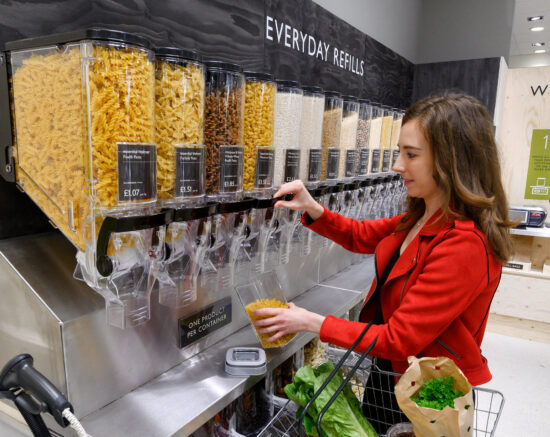Refills and Dispensing – Designing a more Sustainable Future.
When, in the summer of 2019, leading British supermarket Waitrose launched Unpacked – a pioneering packaging-free refill option for some of its own-brand lines – it was met with some scepticism. How much impact could the refill model have in solving one of our biggest environmental challenges? And how much influence can a retailer have in shaping more sustainable behaviours?
At Waitrose, the customer response was overwhelmingly positive, with over 80% of their customers saying they would shop Unpacked again and wanted an expanded range. And since launch, the Unpacked offer has helped save hundreds of tonnes of plastic and packaging. Waitrose is expanding their scheme further, to include more products and integrating it into the regular aisles in its shops, rather than being a dedicated space.

Today, consumer enthusiasm for packaging-free and refillable options continues to grow. Yet, despite the reassuring signs that the current pandemic has not hindered consumers’ appetite for sustainable practices, the wide adoption of refills and dispensing models continues to present significant challenges.
Firstly, the customer experience on sustainable purchase models comes with a significant shift in influencing power. Who is pushing who to do the right thing? Is it the retailer, the brand or the customer?
Secondly, and perhaps more crucially, consumer brands have used packaging as a differentiator for decades. If packaging is going to be reduced, or disposed of altogether, how can these brands assert their presence in shops and drive customer loyalty?
Lastly, the rise of online shopping during the pandemic also opens up new challenges around transportation, the functional requirements of packaging and its sustainable credentials.
The how and where of the experience
To understand the broader challenge in refills and dispensing, the categorisation by the Ellen MacArthur Foundation, leaders in circular economy practices, is a good place to start. By considering the methods of delivery – ‘on the go’ or ‘at home’ – and expected consumer behaviours – ‘return’ or ‘refill’, we can begin to understand how sustainable purchase choices might fit into our everyday lives, and their limitations:
- Refill on the go, where you fill up your water bottle, washing up liquid, coffee grounds etc. from a dispensing point. Waitrose’s ‘Unpacked’ offering falls into this category.
- Return on the go, where you drop off your previously purchased product at a designated point for recycling – such as SodaStream canisters.
- Refill at home, where you receive a new product at home to refill your container, often transferring product from lightweight temporary packaging to a more practical and sturdier dispenser.
- Return from home, where products are picked up and dropped off at your doorstep, the milkman being a good, old-fashioned example

Across all those categories, the product and service experience must successfully meet the needs of consumers, brands and retailers alike. But unfortunately, those needs are not always aligned.
During our research at PDD, we have identified that, when it comes to refills and dispensing units, consumers tend to prioritise convenience, sustainability and – more recently in the context of the pandemic – hygiene standards. Brands on the other hand, tend to focus on visual branding and presentation and want to control the customer experience and reduce any risk of contamination. For retailers, reputation and sustainability credentials come first, as well their ambition to get customers to return to their physical or virtual stores for repeat purchases.
Addressing those conflicting demands requires careful consideration and a coherent design and development process that keeps customers at the centre. Otherwise, there is a risk of ending up with lowest common denominator solutions that turn sustainable shopping into something functional and unengaging – a ‘non-descript’ experience that does not communicate the advantages of the product and fails to persuade new customers to try and adopt sustainable behaviours. This would be a missed opportunity for brands, for consumers, and the world.
A point of no return?
To create a better, more integrated sustainable shopping experience, collaboration is key. Brands, retailers and manufacturers need to work together to accept the inherent limitations of the existing refill and dispensing models and use those constraints to develop new, more holistic people-centred solutions.
From a brand perspective, refilling at home offers excellent opportunities for innovation – the brand has a direct relationship with the consumer and control over delivery and presentation. On the other hand, it is difficult to keep the carbon footprint low because of the need for postage and temporary packaging.
In recent months, we have seen how the pandemic has given a boost to brands offering products through the refill-at-home route. Customers have welcomed the option to avoid queues and infection risks at supermarkets, whilst an increase in working from home did away with the fuss over deliveries. An example is Wild, a unisex deodorant subscription that delivers a refill-at-home product with pods that fit into a re-usable case and packaging that 100% recyclable and compostable. With a near-circular approach to waste, the brand has gained recognition amongst the informed, environment-conscious consumer.

But, in many ways, Wild is still the exception rather than the norm. Despite their best intentions, many consumer brands still struggle to define what a sustainable, convenient refill or dispensing experience is, particularly when the broader supply chain elements are taken into consideration.
The challenge is particularly obvious with ‘return-from-home’ services, whose carbon footprint is the same as it would be if the product was in the shop, and potentially double if the empty packaging is posted separately. We have recently seen brands look back to successful delivery models of past decades to try to address this issue, like fizzy-pop lorries where customers would buy the product and pay a deposit for the bottle, which would reduce the price of their next purchase when the van came back. A modern-day version of that is Loop which, in partnership with retail giant Tesco in the UK, offering a similar service for reusable containers filled with household brand products. With a limited number of brands on offer, there are still issues here to be addressed in terms of personalisation and consumer choice.
‘Refilling-on-the-go’, say, at your local supermarket presents an even bigger conundrum. If consumers have the responsibility of cleaning containers themselves and fail to clean it properly, fill it with food from a supermarket and then get food poisoning, the vendor might be held liable. Refilling stations were starting to appear in UK supermarkets before the pandemic, but the risk of infection from shared interfaces meant that plenty of these initiatives were paused. Even without considering the current health concerns, retailers would still be responsible for the maintenance, cleaning and presentation of these stations which can easily become messy or be mishandled by customers. This creates a tension with brands who lose control over customer experience and find their opportunities for aesthetic control reduced, presenting a challenge to brand differentiation.
Unthinking a more sustainable world
If as innovators we are to transform the way people shop and drive more sustainable behaviours around refills and dispensing, we need to ‘unthink’ and deconstruct how we look at everyday consumer products and experiences.
For instance, many of us are accustomed now to use a shower gel but, until relatively recently, most people used to be happy with bars of soap which require only a simple paper wrapper. Whereas the bar of soap remains flawed – it can become squidgy and slippery – there is opportunity here for improvement, with a design solution that might blend the convenience with a more sustainable footprint.
Homethings in the UK has addressed this challenge in the context of the home. It provides household cleaning products in the form of dissolvable tablets, eliminating the need to ship water. Water and air in products take up enormous amounts of weight and space so this is an elegant solution that might serve as an inspiration for others.

A richer experience
Wild, Homethings and Waitrose Unpacked are all laudable initiatives, but of limited scale. And whilst retailers are testing and developing new models, mass-market FMCG brands have largely fallen behind.
At a time when consumers are painfully aware of the impact of human activity on the climate and the environment, the pressure to provide a genuinely sustainable solutions is mounting. However, if sustainability is going to succeed in the long term, those solutions must also be appealing and desirable.
Refillables and dispensing present a fabulous opportunity for experience enrichment and customisation. Wild deodorant, for example, offers an excellent array of 9 scents including limited edition options. Perso, a ‘soon-to-hit-the-market’ initiative from L’Oreal, is an AI-powered home system that customises a user’s skincare, lipstick and foundation and results in a fully personalised experience. Brands should take note that an exciting level of personalisation is possible by formulating a base product and layering desired add-ons on top, giving people the chance to make the product ‘theirs’.
In rapidly changing landscapes, such as we are experiencing now, significant opportunities in refills and dispensing exist for those willing to try out new things. Our historic understanding of consumer priorities and habits no longer applies, and we need to be prepared to imagine new products and services through research, scrutiny, and testing.
Brands looking to take the lead in this area need to step back, think bigger and consider all facets of the product lifecycle for consumers, manufactures, distributors and retailers.
To succeed, they need to embrace a holistic human centred design approach and adopt a future-thinking mindset, with integrated, personalised experiences that support sustainable consumer behaviours not just now, but ten years into the future.



